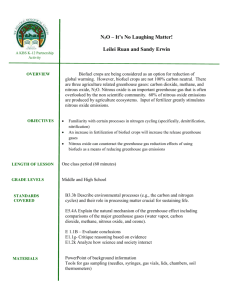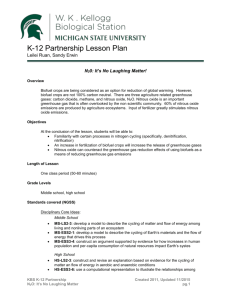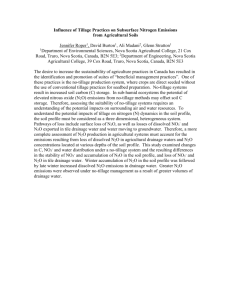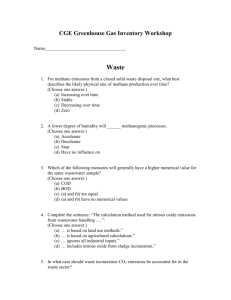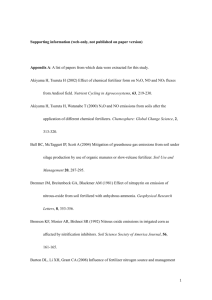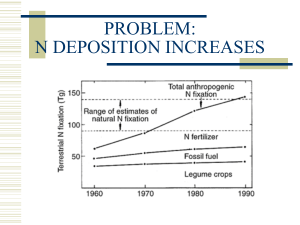Di_HJ_Report of the GRASS Award public version
advertisement
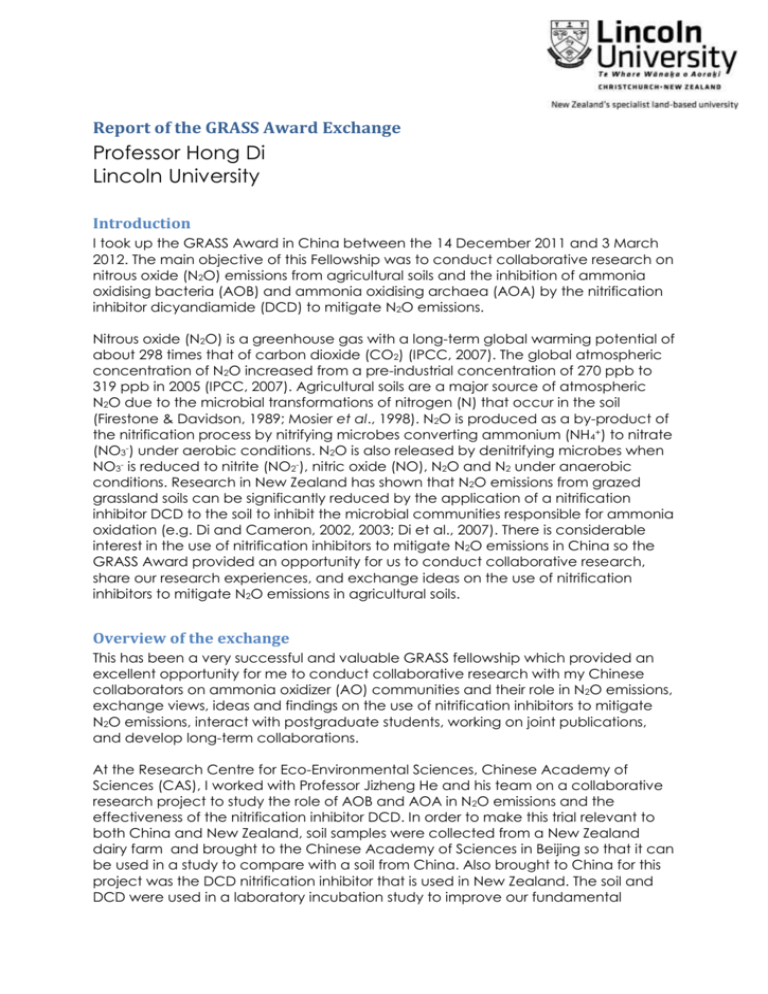
Report of the GRASS Award Exchange Professor Hong Di Lincoln University Introduction I took up the GRASS Award in China between the 14 December 2011 and 3 March 2012. The main objective of this Fellowship was to conduct collaborative research on nitrous oxide (N2O) emissions from agricultural soils and the inhibition of ammonia oxidising bacteria (AOB) and ammonia oxidising archaea (AOA) by the nitrification inhibitor dicyandiamide (DCD) to mitigate N2O emissions. Nitrous oxide (N2O) is a greenhouse gas with a long-term global warming potential of about 298 times that of carbon dioxide (CO2) (IPCC, 2007). The global atmospheric concentration of N2O increased from a pre-industrial concentration of 270 ppb to 319 ppb in 2005 (IPCC, 2007). Agricultural soils are a major source of atmospheric N2O due to the microbial transformations of nitrogen (N) that occur in the soil (Firestone & Davidson, 1989; Mosier et al., 1998). N2O is produced as a by-product of the nitrification process by nitrifying microbes converting ammonium (NH4+) to nitrate (NO3-) under aerobic conditions. N2O is also released by denitrifying microbes when NO3- is reduced to nitrite (NO2-), nitric oxide (NO), N2O and N2 under anaerobic conditions. Research in New Zealand has shown that N2O emissions from grazed grassland soils can be significantly reduced by the application of a nitrification inhibitor DCD to the soil to inhibit the microbial communities responsible for ammonia oxidation (e.g. Di and Cameron, 2002, 2003; Di et al., 2007). There is considerable interest in the use of nitrification inhibitors to mitigate N2O emissions in China so the GRASS Award provided an opportunity for us to conduct collaborative research, share our research experiences, and exchange ideas on the use of nitrification inhibitors to mitigate N2O emissions in agricultural soils. Overview of the exchange This has been a very successful and valuable GRASS fellowship which provided an excellent opportunity for me to conduct collaborative research with my Chinese collaborators on ammonia oxidizer (AO) communities and their role in N2O emissions, exchange views, ideas and findings on the use of nitrification inhibitors to mitigate N2O emissions, interact with postgraduate students, working on joint publications, and develop long-term collaborations. At the Research Centre for Eco-Environmental Sciences, Chinese Academy of Sciences (CAS), I worked with Professor Jizheng He and his team on a collaborative research project to study the role of AOB and AOA in N2O emissions and the effectiveness of the nitrification inhibitor DCD. In order to make this trial relevant to both China and New Zealand, soil samples were collected from a New Zealand dairy farm and brought to the Chinese Academy of Sciences in Beijing so that it can be used in a study to compare with a soil from China. Also brought to China for this project was the DCD nitrification inhibitor that is used in New Zealand. The soil and DCD were used in a laboratory incubation study to improve our fundamental understanding on the origins of N2O, the role of AOB and AOA, and the effect of DCD on N2O emissions. In order to trace the origins of N2O, the N fertiliser source used in the incubation study was labelled with stable isotopes . Measurements included soil mineral N dynamics, nitrification and denitrification enzyme activities, N2O emissions, and AOB and AOA community abundance and activity.. This was a project that was at the forefront of the field, so a number of technical challenges needed to be overcome. The project is continuing and samples will be analysed in the next few months. The findings will significantly increase our understanding of the origins of N2O, the role of different AO communities, and the effect of DCD on these microbial communities and processes. While at the CAS in Beijing, it also provided an opportunity to jointly work on a manuscript for publication . The first draft has been produced and will be submitted shortly after further editing and internal reviews. This article will provide a timely update and a critical analysis on this topical area. The fact that I was in the CAS laboratory in person made the discussion and my contribution to the work programme so much easier than communicating through email. The results from the collaborative research project will be published when all the trial work is completed and all the samples have been analysed. Another important aspect of the GRASS fellowship is that it provided a great opportunity for me to interact with the postgraduate students at the CAS in Beijing who are part of Professor He’s team. I held a seminar/discussion session with the postgraduate students on the use of nitrification inhibitors to inhibit AOB and AOA in the soil to reduce N2O emissions. I found this to be very useful for me to explain the N2O work that we have been doing in New Zealand, and also for me to learn about the work at the CAS. In addition to working with Professor He’s team at the CAS in Beijing, I also visited other research groups who are conducting research on N2O emissions and the use of DCD to reduce N2O emissions. This included the Subtropical Institute of Agriculture in Changsha that is working on N2O emissions in paddy fields (for rice production) and the use of DCD to reduce N2O emissions; Huazhong Agricultural University that has research programmes on N2O emissions from vegetable systems, and its mitigation with DCD; Hebei Agricultural University that works on N2O emissions from glasshouse vegetable production fields; and Zhejiang University with interests in N2O emissions as affected by different soil management systems. Discussions with teams in these institutions were very useful for me to learn about their work programmes, the effect of soil and environmental conditions on the effectiveness of DCD, and for me to share my research experience in New Zealand. Delivery against anticipated outcomes and outputs All the anticipated outcomes and outputs as set out in the contract have been successfully achieved. This is summarised in the following table. Anticipated outcomes To collaborate on research that investigates the effectiveness of the nitrification inhibitor DCD in reducing nitrous oxide emission in China and NZ To study the microbial mechanisms of nitrification inhibition and nitrous oxide emissions by DCD To share and exchange information on the mitigation approaches to nitrous oxide emission in China and NZ to facilitate the transfer of knowledge about mitigation tools To use the knowledge gained during the Chinese trials to enhance the research programme in NZ and further the understanding on the various microbial, soil and environmental factors that affect nitrous oxide emissions from the soil A seminar given to the EcoEnvironmental Research Centre in CAS. Transfer of research protocol on the use of nitrification inhibitor to EcoEnvironmental Research Centre in CAS A collaborative journal article submitted to a peer reviewed journal Delivery Achieved successfully through the joint collaborative research project. Achieved through the collaborative research project. Achieved through seminar/discussions, collaborative research project and joint publications. Achieved. The collaborative research project will provide insights into the role played by AOB and AOA in N2O production and the effectiveness of DCD in mitigating N2O emissions. The discussions with the teams in the different organisations have significantly increased my understanding of the efficacy of DCD in reducing N2O emissions in intensive vegetable production systems and in paddy fields. This complements those trials that have been conducted in New Zealand on grazed pasture soils Achieved Achieved through the collaborative research project A manuscript has been drafted and after further editing and internal reviews, will be submitted New research opportunities and enduring relationships/partnerships Discussions were held at length with the research teams that I visited during the exchange to identify new research opportunities and develop long-term collaborative relationships. Three possible areas of continued collaboration were identified: Joint application of research funding in China to fund joint research projects; exchange of staff and students; and joint publications. Concluding remarks This GRASS Award has been extremely valuable. It enabled me to work in person in the Chinese laboratories to conduct collaborative research, have informative discussions, exchange views and ideas on N2O research and the use of DCD to mitigate emissions, prepare joint grant applications, and contribute to joint publications. The joint research project conducted will provide fundamental knowledge on the origins of N2O, the role played by ammonia oxidising microbial communities, and the efficacy of DCD in inhibiting the AOs and in reducing N2O emissions.. The joint publications will enhance New Zealand’s reputation in this area, particularly in China. The knowledge gained through the joint research projects, exchanges and publications, will complement, inform and enhance similar research in New Zealand. Hopefully these collaborations will lead to improved solutions to the biggest challenge that humanity is faced with today – climate change. I hope more scientists will take up this Award to enhance research collaborations among different scientists in New Zealand and other countries. Climate change is a global issue and it will require concerted efforts of all the nations on this planet to minimize its impact. Collaboration of scientists from different countries is an important part of this concerted effort. Acknowledgement I am grateful to MAF through NZAGRC for the provision of the GRASS Award. References Di, H.J. & Cameron, K.C. 2002. The use of a nitrification inhibitor, dicyandiamide (DCD), to decrease nitrate leaching and nitrous oxide emissions in a simulated grazed and irrigated grassland. Soil Use and Management 18, 395-403. Di, H.J. & Cameron, K.C. 2003. Mitigation of nitrous oxide emissions in spray-irrigated grazed grassland by treating the soil with dicyandiamide, a nitrification inhibitor, Soil Use and Management 19, 184-290. Di, H.J., Cameron, K.C. & Sherlock, R.R. 2007. Comparison of the effectiveness of a nitrification inhibitor, dicyandiamide (DCD), in reducing nitrous oxide emissions in four different soils under different climatic and management conditions. Soil Use and Management 23, 1-9. IPCC. 2007. Climate Change 2007: The Physical Science Basis. Contribution of Working Group I to the Fourth Assessment Report of Intergovernmental Panel on Climate Change. IPCC Secretariat, Geneva, Switzerland. Firestone, M.K. & Davidson, E.A. 1989. Microbiological basis of NO and N2O production and consumption in soils. In: Exchange of Trace Gases between Terrestrial Ecosystems and the Atmosphere (eds M.O. Andreae & D.S. Schimel), pp. 7-21. John Wiley & Sons, Chichester. Mosier, A., Kroeze, C., Nevison, C., Oenema, O., Seitzinger, S. & van Cleemput, O. 1998. Closing the global N2O budget: nitrous oxide emissions through the agricultural nitrogen cycle. Nutrient Cycling in Agroecosystems 52, 225-248.
